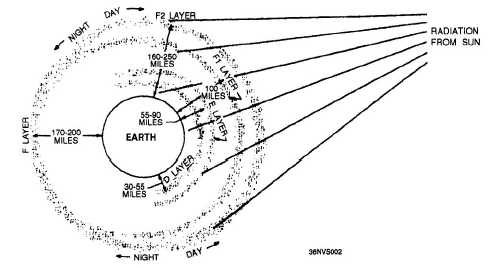on the time of day and the season of the year.
Another important factor in determining layer
density is known as recombination.
Recombination
Recombination is the reverse process of
ionization. It occurs when free electrons and positive
ions collide, combine, and return the positive ions to
their original neutral state.
Like ionization, the recombination process
depends on the time of day. Between early morning
and late afternoon, the rate of ionization exceeds the
rate of recombination. During this period the ionized
layers reach their greatest density and exert
maximum influence on radio waves. However, during
the late afternoon and early evening, the rate of
recombination exceeds the rate of ionization, causing
the densities of the ionized layers to decrease.
Throughout the night, density continues to decrease,
reaching its lowest point just before sunrise. It is
important to understand that this ionization and
recombination process varies, depending on the
ionospheric layer and the time of day. The following
paragraphs provide an explanation of the four
ionospheric layers.
Ionospheric Layers
The ionosphere is composed of three distinct
layers, designated from lowest level to highest level
(D, E, and F) as shown in figure 1-2. In addition, the
F layer is divided into two layers, designated F1 (the
lower level) and F2 (the higher level).
The presence or absence of these layers in the
ionosphere and their height above the earth vary
with the position of the sun. At high noon, radiation
in the ionosphere above a given point is greatest,
while at night it is minimum. When the radiation is
removed, many of the particles that were ionized
recombine. During the time between these two
conditions, the position and number of ionized layers
within the ionosphere change.
Since the position of the sun varies daily,
monthly, and yearly with respect to a specific point
on earth, the exact number of layers present is
extremely difficult to determine. However, the
following general statements about these layers can
be made.
D LAYER.— The D layer ranges from about 30
to 55 miles above the earth. Ionization in the D layer
is low because less ultraviolet light penetrates to this
level. At very low frequencies, the D layer and the
ground act as a huge waveguide, making communica-
tion possible only with large antennas and high-
power transmitters. At low and medium frequencies,
the D layer becomes highly absorptive, which limits
the effective daytime communication range to about
200 miles. At frequencies above about 3 MHz, the D
layer begins to lose its absorptive qualities.
Figure 1-2.—Layers of the ionosphere.
1-3

